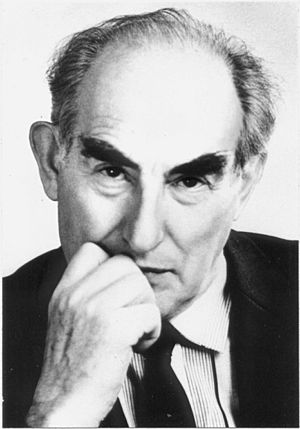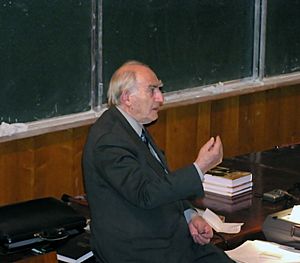Vitaly Ginzburg facts for kids
Quick facts for kids
Vitaly Ginzburg
|
|
|---|---|
 |
|
| Born |
Vitaly Lazarevich Ginzburg
4 October 1916 Moscow, Russian Empire
|
| Died | 8 November 2009 (aged 93) Moscow, Russia
|
| Resting place | Novodevichy Cemetery, Moscow |
| Nationality | |
| Alma mater | Moscow State University (KN 1938) (DN 1942) |
| Known for | Ginzburg–Landau theory Ginzburg criterion Transition radiation Undulator |
| Spouse(s) | Olga Zamsha Ginzburg (1937–1946; divorced; 1 child) Nina Yermakova Ginzburg (m. 1946) |
| Awards |
|
| Scientific career | |
| Fields | Theoretical physics |
| Institutions | P. N. Lebedev Physical Institute, Russian Academy of Sciences N. I. Lobachevsky State University of Nizhny Novgorod |
| Doctoral advisor | Igor Tamm |
| Doctoral students | Viatcheslav Mukhanov Leonid Keldysh |
Vitaly Lazarevich Ginzburg (Russian: Вита́лий Ла́заревич Ги́нзбург; 4 October 1916 – 8 November 2009) was a Russian physicist. He won the Nobel Prize in Physics in 2003. He shared the prize with Alexei Abrikosov and Anthony Leggett. They were honored for their important work on superconductors and superfluids.
Ginzburg spent his career in the former Soviet Union. He was a key scientist in the country's defense programs. He worked on designing advanced technologies. He became a member of the Russian Academy of Sciences. He also led the Department of Theoretical Physics at the Lebedev Physical Institute. Later in his life, Ginzburg became a strong atheist. He often spoke out against the influence of the Russian Orthodox Church in Russian society.
Contents
Who Was Vitaly Ginzburg?
Vitaly Ginzburg was born in Moscow on October 4, 1916. His family was Jewish. His father, Lazar Yefimovich Ginzburg, was an engineer. His mother, Augusta Wildauer, was a doctor.
Early Life and Education
Ginzburg studied at Moscow State University. He earned his first advanced degree in 1938. He completed his higher degree in 1942. In 1944, he joined the Communist Party of the Soviet Union.
Amazing Discoveries in Physics
Ginzburg made many important discoveries in physics. One of his key works was the Ginzburg–Landau theory. He developed this theory with Lev Landau in 1950. It helps explain how superconductivity works. Superconductors are materials that can carry electricity with no resistance.
He also studied how electromagnetic waves travel through plasmas. Plasmas are like a gas of charged particles. This research helped us understand parts of Earth's atmosphere, like the ionosphere. Ginzburg also created a theory about where cosmic radiation comes from. Cosmic rays are high-energy particles from space.
Ginzburg also played a role in helping modern genetic science return to the Soviet Union. He was part of a group of scientists who challenged outdated ideas in agriculture.
Life Beyond Science
In 1937, Ginzburg married Olga Zamsha. Later, in 1946, he married Nina Ginzburg. Nina had been held by authorities due to false accusations.
Ginzburg was the main editor of a scientific journal called Uspekhi Fizicheskikh Nauk. He also started and led the Academic Department of Physics and Astrophysics Problems. This department was at the Moscow Institute of Physics and Technology.
Ginzburg identified as a non-religious Jew. After the collapse of communism in the Soviet Union, he became very active in Jewish community life in Russia. He was on the board of directors for the Russian Jewish Congress. He was also known for fighting against anti-Semitism and supporting the state of Israel.
Speaking Up for Others
In the 2000s, Ginzburg was active in politics. He supported groups that wanted more freedom and human rights in Russia. He spoke up for scientists like Igor Sutyagin and Valentin Danilov. These scientists had been accused of serious crimes by the government. In 2009, Ginzburg criticized Russia's security service, the FSB. He said it was becoming too powerful and harmful to Russia.
Ginzburg worked at the Lebedev Physical Institute in Moscow starting in 1940. This institute is a very important place for physics research in Russia. Many Nobel Prize winners in physics from Russia have studied or worked there.
Beliefs and Views
Ginzburg was a strong atheist. He held this belief even when the Soviet government was against religion. He continued to be an atheist when religion became popular again in post-Communist Russia. He often criticized the influence of religious leaders in the media. He also wrote several books about religion and atheism. Because of his views, some religious groups criticized him. He was one of many scientists who signed an open letter against the growing influence of the church in Russia.
His Final Years
Vitaly Ginzburg passed away in Moscow on November 8, 2009. He died from a cardiac arrest. He had been unwell for several years. Three years before his death, he said, "In general, I envy believers. I am 90, and [am] being overcome by illnesses. For believers, it is easier to deal with them and with life's other hardships. But what can be done? I cannot believe in resurrection after death."
Many important people shared their sadness at his passing. The Prime Minister of Russia, Vladimir Putin, sent his condolences. He called Ginzburg an "extraordinary personality" with "outstanding talent." The President of Russia, Dmitry Medvedev, said Ginzburg was a "top physicist of our time." He added that Ginzburg's discoveries had a huge impact on science around the world.
Ginzburg was buried on November 11 at the Novodevichy Cemetery in Moscow. This cemetery is the resting place for many famous Russian figures.
Awards and Recognition

- Medal "For Valiant Labour in the Great Patriotic War 1941–1945" (1946)
- Medal "In Commemoration of the 800th Anniversary of Moscow" (1948)
- Stalin Prize (1953)
- Order of Lenin (1954)
- Order of the Badge of Honour, twice (1954, 1975)
- Order of the Red Banner of Labour, twice (1956, 1986)
- Lenin Prize (1966)
- Medal "For Valiant Labour. To commemorate the 100th anniversary of the birth of Vladimir Ilyich Lenin" (1970)
- Marian Smoluchowski Medal (1984)
- Elected a Foreign Member of the Royal Society (ForMemRS) (1987)
- Gold Medal of the Royal Astronomical Society (1991)
- Wolf Prize in Physics (1994/95)
- Vavilov Gold Medal (1995)
- Lomonosov Gold Medal (1995)
- Order "For Merit to the Fatherland", 3rd class (1996)
- Elected a Fellow of the American Physical Society (2003)
- Nobel Prize in Physics (2003)
- Order "For Merit to the Fatherland", 1st class (2006)
See also
 In Spanish: Vitali Guínzburg para niños
In Spanish: Vitali Guínzburg para niños

